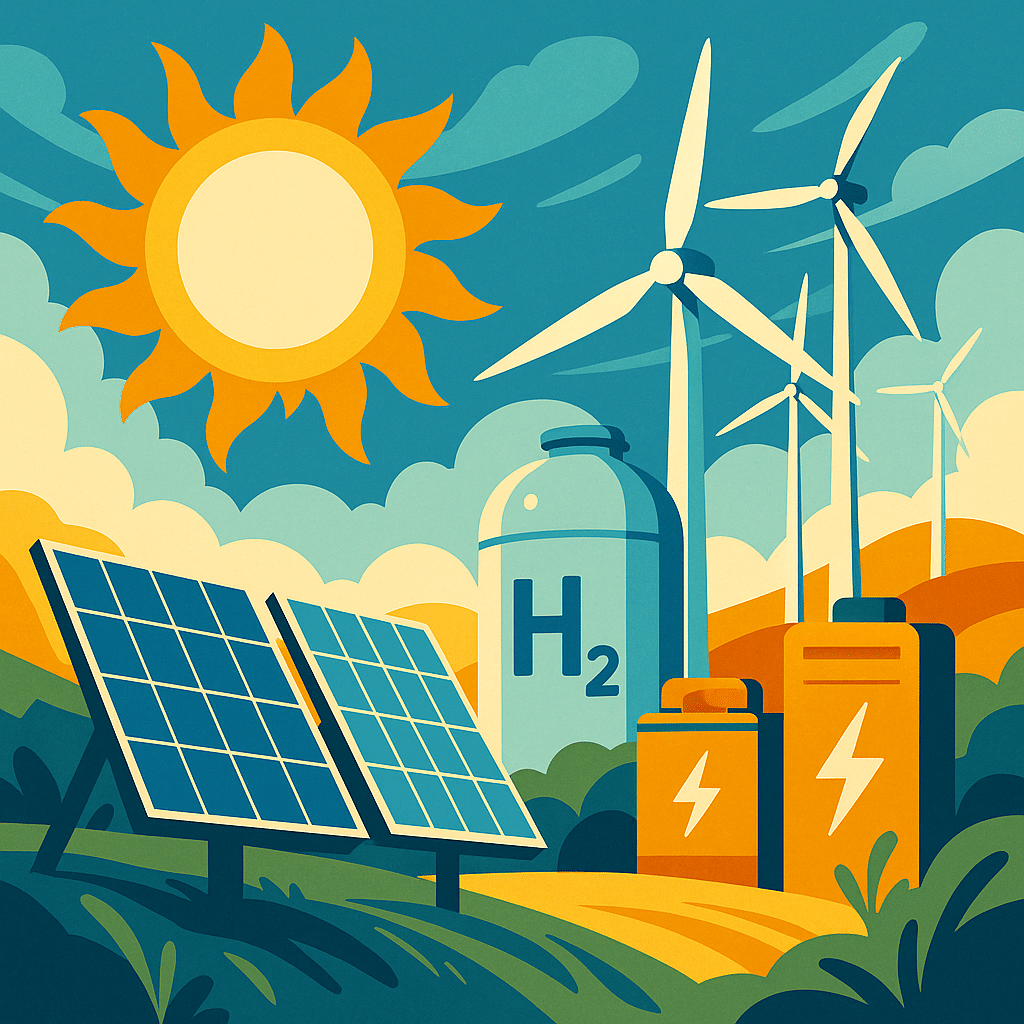The renewable energy sector is undergoing a significant transformation, driven by technological advancements, policy shifts, and global investment trends. In 2024, renewable energy accounted for over 90% of global power capacity additions, signaling a decisive move away from fossil fuels. So what is it about the future of renewable energy?

Key Trends Shaping the Future of Renewable Energy
1. Solar Energy Leading the Charge
Solar power continues to dominate the renewable energy landscape. In 2024, solar photovoltaic installations increased by 35% year-on-year, contributing significantly to the global energy mix . Innovations such as perovskite solar cells have achieved efficiencies over 25%, with tandem cells surpassing 30%, making solar energy more accessible and cost-effective .IEABloombergNEFratedpower.com
2. Advancements in Energy Storage
The growth of renewable energy sources has been complemented by significant advancements in energy storage technologies. Energy storage installations rose by 76% in 2024, with the global market projected to reach $31.72 billion by 2031 . Emerging technologies like solid-state and flow batteries offer higher energy densities and longer lifespans, enhancing grid reliability and facilitating the integration of intermittent renewable sources.ratedpower.com+1BloombergNEF+1
3. Emergence of Green Hydrogen
Green hydrogen is gaining traction as a clean energy carrier, especially for sectors that are challenging to electrify. Between 2020 and 2024, investments in green hydrogen projects increased from $10 billion to $75 billion, with electrolyzer capacity doubling . Countries like Saudi Arabia and the United Kingdom are investing in large-scale green hydrogen facilities, aiming to decarbonize industries and transportation .ratedpower.comWikipedia
4. Expansion of Offshore Wind Energy
Offshore wind energy is experiencing rapid growth, with global capacity expected to reach 61 GW by 2025, up from 25 GW in 2020 . This expansion is driven by technological advancements and supportive policies, particularly in regions like the North Sea and East Asia.World Economic Forum
5. Integration of Artificial Intelligence
Artificial Intelligence (AI) is playing an increasingly vital role in optimizing renewable energy systems. AI algorithms are being used to forecast energy production, manage grid operations, and enhance energy efficiency. However, the growing energy demands of AI and data centers are also prompting the need for more sustainable energy solutions .World Economic Forum
Global Investment and Policy Landscape
Investment in renewable energy is reaching unprecedented levels. In 2025, capital investment in energy and natural resources is projected to exceed $1.5 trillion, marking a 6% increase from the previous year . Governments worldwide are implementing policies to support this growth. For instance, the United Kingdom’s “Clean Power 2030” plan aims to accelerate the deployment of renewable energy projects and reform grid connection systems .World Economic ForumThe Guardian
Community and Decentralized Energy Initiatives
Community-led renewable energy projects are transforming energy access in remote and underserved regions. In Latin America, initiatives like the solar energy system in Alto Mishagua, Peru, are providing reliable electricity to Indigenous communities, fostering autonomy and sustainability . These decentralized solutions are crucial for achieving equitable energy transitions.The Guardian
Conclusion
The future of renewable energy is marked by rapid technological advancements, significant investments, and supportive policies. As solar and wind power continue to expand, complemented by innovations in energy storage and green hydrogen, the global energy landscape is poised for a sustainable transformation. Community-driven initiatives further underscore the importance of inclusive and equitable energy solutions.
References:
- International Renewable Energy Agency (IRENA). (2025). Record-Breaking Annual Growth in Renewable Power Capacity. Retrieved from https://www.irena.org/News/pressreleases/2025/Mar/Record-Breaking-Annual-Growth-in-Renewable-Power-CapacityIRENA
- RatedPower. (2025). Innovation in renewable energy: Developments expected in 2025. Retrieved from https://ratedpower.com/blog/solar-power-technology/ratedpower.com
- BloombergNEF. (2025). Five Energy Transition Lessons for 2025. Retrieved from https://about.bnef.com/blog/five-energy-transition-lessons-for-2025/BloombergNEF+1BloombergNEF+1
- World Economic Forum. (2025). 4 key trends to watch in clean energy technology in 2025. Retrieved from https://www.weforum.org/stories/2025/01/4-key-trends-to-watch-in-clean-energy-technology-in-2025/World Economic Forum+1World Economic Forum+1
- The Guardian. (2025). A future on our terms: how community energy is lighting up Latin America. Retrieved from https://www.theguardian.com/global-development/2025/may/08/latin-america-community-energy-indigenous-lighting-electricity-solar-pollution-diesel-just-transitionThe Guardian
- The Guardian. (2024). Ed Miliband pledges ‘most ambitious reforms to UK energy system in generations’. Retrieved from https://www.theguardian.com/environment/2024/dec/13/ed-miliband-pledges-most-ambitious-reforms-to-uk-energy-system-in-generationsThe Guardian
- World Economic Forum. (2025). 5 trends shaping the energy world in 2025. Retrieved from https://www.weforum.org/stories/2025/03/5-energy-trends-2025/World Economic Forum+1World Economic Forum+1
- Wikipedia. (2025). Green hydrogen. Retrieved from https://en.wikipedia.org/wiki/Green_hydrogenWikipedia
- Statista. (2025). Offshore Wind Energy to Double. Retrieved from https://www.statista.com/chart/23455/wind-solar-capacity-outlook/Statista+1Statista+1
- Statista. (2025). Wind, Solar Dominate Energy Future. Retrieved from https://www.statista.com/chart/23455/wind-solar-capacity-outlook/









